Today, fashion and technology intersect more seamlessly, which is why fashion app development is gaining remarkable momentum more than before.
Amid the COVID-19 pandemic, fashion apps have played a pivotal role in reshaping the way we engage with fashion. During this time the fashion industry has faced unprecedented challenges.
However, fashion apps swiftly adapted to the changing landscape and offered innovative solutions to cater to the evolving needs of customers.
Many popular brands like Nike, Bershka, Hermes, and many others have their fashion e-commerce apps. By 2023, the global fashion e-commerce market is forecast to reach over 820 Bn U.S. dollars. By 2027 it could reach over 1.2 trillion U.S. dollars.
Another prominent example during this time was the rise of virtual try-on and fitting room apps. As physical shopping becomes limited and risky, these apps allow users to virtually try on clothes, experiment with styles, and make informed purchase decisions from the safety of their homes.
Whether it’s virtual fitting rooms and personalized style recommendations to seamless e-commerce experiences, fashion apps are revolutionizing the way we shop, express ourselves, and stay on trend.
If you are an entrepreneur who wants to invest in fashion app development, you are in the right place.
Fashion App Development: Market Statistics
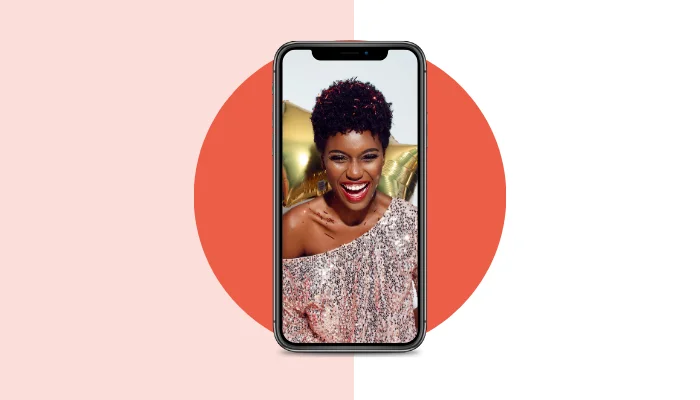
Fashion app development is a dynamic and rapidly evolving sector that intersects fashion and technology, reshaping how we engage with style and clothing.
According to Statista, the global fashion e-commerce market was valued at US $668 Bn in 2021, and it is estimated that it could reach over US $1.2 Trillion by 2025.
The fashion app market has experienced explosive growth in recent years. Mobile devices have become the preferred platform for fashion shopping.
Moreover, the revenue in the fashion segment of the e-commerce market in Asia is forecast to continue to increase between 2023 and 2027 by 147.3 Bn in U.S. dollars.
Statistically, over 80% of fashion e-commerce traffic comes from mobile devices, highlighting the importance of fashion apps in driving sales.
Moreover, AI plays a pivotal role in the fashion app market. Apps that leverage AI for personalized recommendations have witnessed a significant increase in user engagement and sales.
AI-driven product recommendations can lead to a 30% higher conversion rate. Fashion apps have a global reach, and the Asia-Pacific region, including countries like China and India, is a burgeoning market for fashion apps. With this being said, let’s understand what a fashion app is in the next section.
What is a Fashion App?
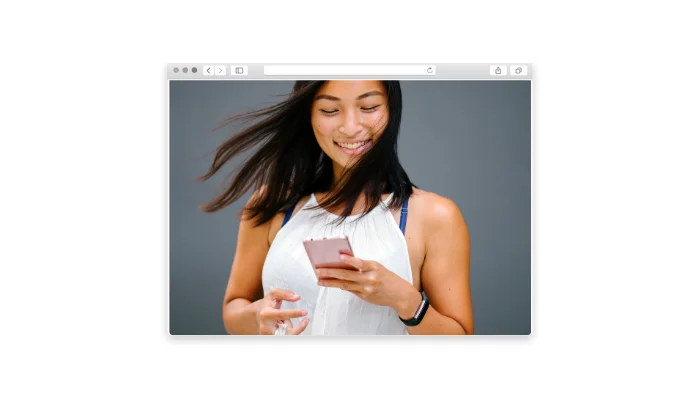
The fashion application is designed to provide fashion-related services such as outfit suggestions, shopping assistance, style inspiration, and social networking for fashion enthusiasts.
Most mobile fashion apps use features like image recognition, AI, ML, and Augmented reality to provide personalized fashion recommendations.
Moreover, online fashion shopping apps allow users to browse a wide range of fashion products, create wish lists, receive notifications about sales and discounts, and connect with other fashion-minded people. These apps often feature products from diverse categories, including iconic styles like Italian clothing, renowned for its elegance and craftsmanship.
Benefits of Fashion Apps for Fashion Business
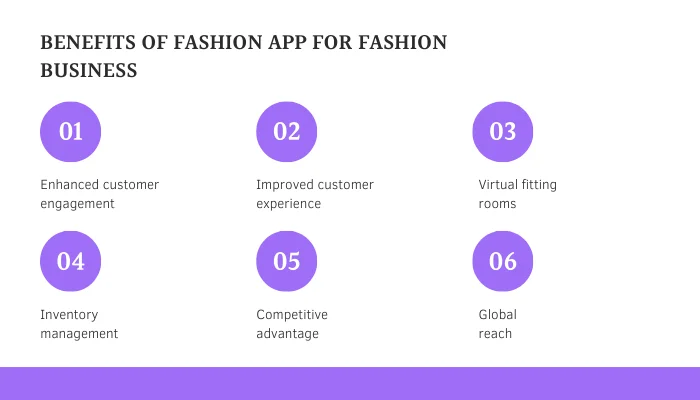
Fashion apps have become a necessity in the fashion industry as more and more people are turning to e-commerce for their shopping needs. These apps provide convenience for shoppers to browse clothes and accessories from the comfort of their homes.
So, if you are a fashion business owner, you need to invest in a fashion app.
However, the best shopping apps in the fashion market are Mango, Nike, Nate, Depop, and others. These apps are easily downloaded and installed on your mobile phone so that users can easily choose from various categories available for purchasing.
Let’s take a look at the benefits of fashion apps:
· Enhanced customer engagement
For fashion businesses, fashion app development is a great way to enhance customer engagement. This way, you can send notifications about new arrivals, promotions, and special events, keeping your audience engaged and informed.
· Improved customer experience
Fashion apps allow for a seamless and user-friendly shopping experience. Moreover, customers can easily browse products, access detailed product information, and make purchases with just a few taps on their smartphones.
· Virtual fitting rooms
Some fashion apps incorporate augmented reality technology to enable customers to virtually try on clothing, helping them visualize how items will look before buying.
· Inventory management
With fashion apps, fashion businesses can effectively manage their inventory, track stock levels in real-time, and prevent overstock or understock situations.
· Competitive advantage
Having a mobile app sets you apart from competitors who may rely solely on websites or brick-and-mortar stores. It demonstrates your commitment to staying up-to-date with technology and meeting the evolving needs of your customers.
· Global reach
Fashion apps have the potential to reach a global audience. With proper localization and marketing efforts, one can expand their fashion business to new markets and demographics.

Key Features of Fashion Mobile App
Fashion Merchant/Store Owner Panel Features |
Admin Panel Features |
Customer Panel Features |
| Register or login | Secure login via email | Social sign-up/ sign-in |
| Manage brand profile and set up stores | View admin dashboard | Browse and filter products |
| Manage product catalog & orders | Manage customers/merchants | View offers and discounts |
| Run product promotions and campaigns | Manage ad campaigns | View loyalty programs/ Live chat support |
| Manage support tickets | Manage product categories | View product details and reviews |
| View reports, metrics & analytics | Manage promotions/rewards/points | Add product to cart/ Wishlist |
| Accept online payments | Manage payments | Create a support ticket |
| Automatic adjustment of inventory on a product sale | Manage customer support | Real-time shipment tracking |
| View user reviews and ratings | Manage referrals/invites | Multiple Payment options |
| Push notifications & alerts | Manage marketing and distribution channels | Apply for return and exchange |
Step-By-Step Guide To Fashion App Development
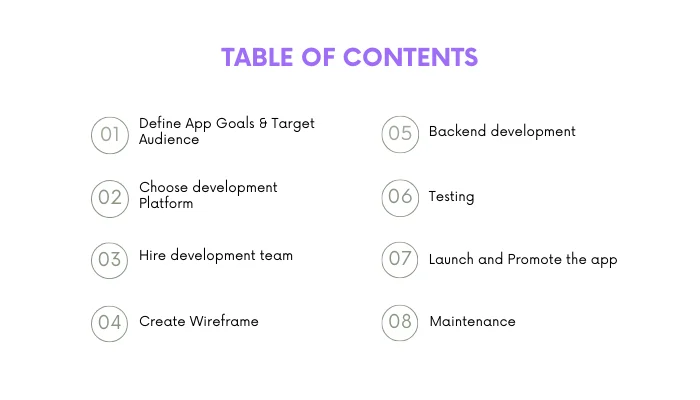
Creating a fashion app involves several steps, from conceptualization to deployment. Before investing in a fashion app, it is recommended to consult the cost with an e-commerce development company. They will provide you with the right guidance.
With that being said, let’s take a look at the step-by-step guide to fashion app development.
1. Define App Goals & Target Audience
The first and foremost important thing is to identify your target audience and their specific fashion-related needs. Now research the market to understand trends, competition, and gaps in the fashion app landscape.
Also, define the value proposition of your app and outline your goals.
2. Choose Development Platform
Now decide on the platform you are going to develop for, such as iOS or Android. If you are choosing cross-platform development use tools like Flutter or React native.
3. Hire a development team
It’s time to hire mobile app developers, a team of skilled designers, and testers to bring your app to life. When you hire experienced professionals, make sure they are familiar with the platform and technologies you choose.
4. Create Wireframe
After hiring, ask your team of UI/UX designers to create a wireframe to visually represent your app’s structure and functionality.
Moreover, it will help you with your app’s interface and user experience. Frontend is the most crucial aspect of the app as it is responsible for the client retention rate.
5. Backend development
Once your app frontend is ready you start the backend development, ask your team of developers to start the backend of the app by writing clean code.
All you have to do is regularly meet with the team to discuss group projects and provide feedback to ensure the app meets your goals.
6. Testing
After the completion of the development, it’s time for testing. It is important to test your app and find bugs and errors. So that you can rectify them in the testing phase.
7. Launch and Promote the app
Once your app is free of bugs and errors and ready to launch in the app store. All you have to do is promote it through various platforms like social media, paid advertising, email marketing, etc.
8. Maintenance
Launching is not the last step, you have to regularly work on the maintenance services to make your fashion app successful.
Continuous maintenance and updating of the fashion app will ensure that it will remain functional for your relevant users.
How Much Does It Cost To Develop A Fashion App?
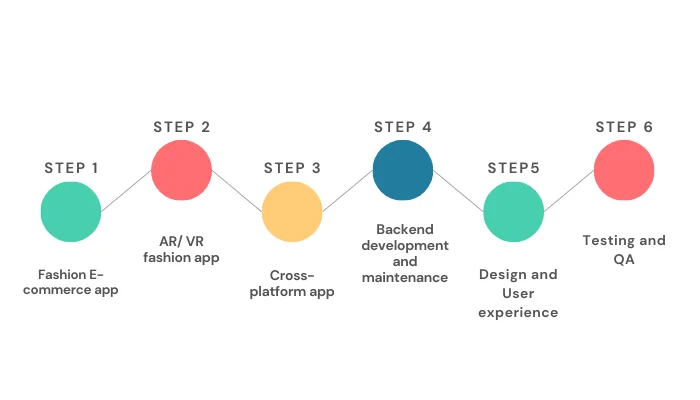
If you want to develop a fashion app, it’s essential to get the estimated cost of the e-commerce fashion app. Although it’s tough to get an exact estimate of the app development cost, you can state a rough estimate of how much the fashion app development will cost.
Several factors affect the cost of development, such as:
- Complexity of the app
- Developing an app for one platform
- Features and functionality of the app
- Design aspects
- Third-party integration services
- Testing of the app
- Location of the developers
- Time taken to develop the app
- Maintenance services
- Marketing and launch
These factors are solely responsible for the cost of app development. Now let’s look at a rough estimate based on typical industry standards.
· Fashion E-commerce app
A feature-rich e-commerce app with capabilities like user accounts, shopping cart, payment processing, and integration with an existing e-commerce platform will cost between $30,000 to $100,000.
· AR/VR fashion app
If you integrate AR/VR features into your fashion app, it will cost you around $100,000 to $300,000 or more, depending on the extent of AR/VR integration.
· Cross-platform app
If you are planning to make your fashion app available for both platforms, consider allocating an additional 50% to 100% of the development cost to accommodate cross-platform development tools like React Native or Flutter.
· Backend development and maintenance
The cost of developing and maintaining the backend infrastructure could add another $20,000 to $50,000 or more depending on complexity.
· Design and User Experience
High-quality design and user experience are essential for a fashion app. Expect to allocate a significant portion of your budget around 20% to 30% to design and UI/UX considerations.
· Testing and QA
Plan for thorough testing and quality assurance to ensure a bug-free and polished app. Testing costs can range from %15 to 20% of the overall budget.
Overall, the rough estimates and actual costs can vary significantly based on your specific requirements and the development team you choose.
Conclusion
The world of fashion is evolving rapidly, and technology has become an integral part of this industry. Fashion app development offers endless possibilities for designers, brands, retailers, and fashion enthusiasts to connect, engage, and thrive in this digital age.
We hope this guide has been an enlightening resource, equipping you with the knowledge and inspiration you need to embark on your fashion app development adventure.
Your fashion app could be the next big thing in the industry, bringing style and convenience to fashion lovers around the globe. If you want to know more feel free to contact us, we are an experienced mobile app development company.
FAQs
A fashion app is a mobile application designed to offer fashion-related services and experiences to users. Whether you’re in the fashion retail business or want to engage fashion enthusiasts, a fashion app can enhance your brand presence and provide unique experiences to your audience.
Key features of a fashion app may include product catalogs, user profiles, shopping carts, secure payment processing, product recommendations, social sharing, virtual try-ons, real-time fashion feeds, and more. The features you choose will depend on your app’s goals and target audience.
The cost of developing a fashion app can vary widely based on factors like complexity, platform(s), design, and features. Rough estimates range from $10,000 for a basic app to $300,000 or more for a feature-rich, AR/VR-enhanced fashion app.
The choice between iOS, Android, or both depends on your target audience and budget. Consider factors like user demographics and preferences when deciding which platforms to prioritize.
The development timeline varies based on the app’s complexity and features. Simple apps may take a few months, while more advanced apps can take six months or longer. Effective project management can help streamline the timeline.
Investing in professional UI/UX design is crucial for creating an appealing and user-friendly fashion app. Hire experienced designers who understand the latest design trends and best practices.
Security is paramount for e-commerce fashion apps. Ensure robust encryption, secure payment gateways, and compliance with industry standards. Regular security audits are also essential.
AR and VR can provide immersive shopping experiences, such as virtual try-ons or 360-degree product views. They enhance user engagement and can set your fashion app apart from competitors.

Niketan Sharma, CTO, Nimble AppGenie, is a tech enthusiast with more than a decade of experience in delivering high-value solutions that allow a brand to penetrate the market easily. With a strong hold on mobile app development, he is actively working to help businesses identify the potential of digital transformation by sharing insightful statistics, guides & blogs.
Table of Contents




No Comments
Comments are closed.